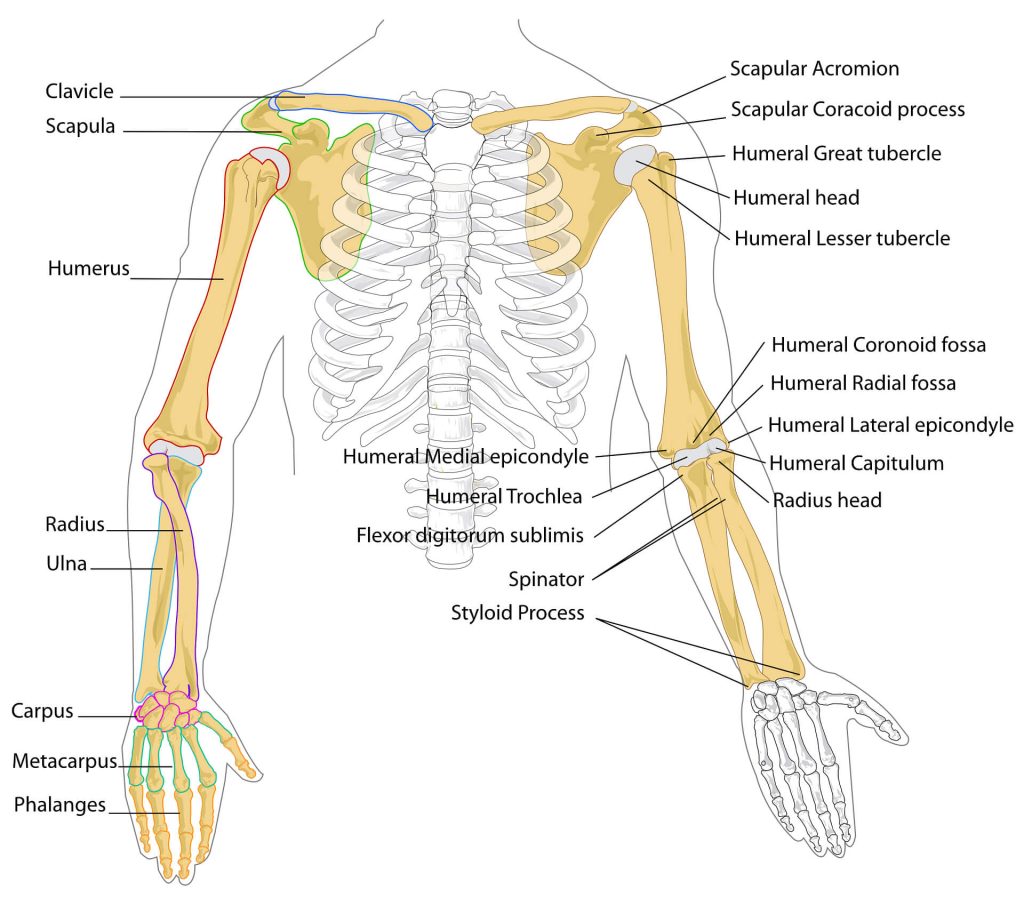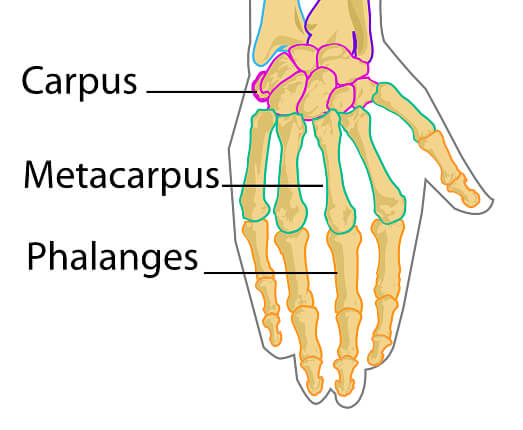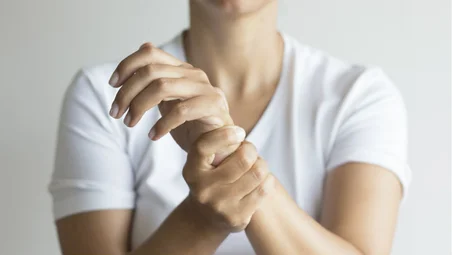Arm, wrist and hand injuries can cause longer term problems with daily living and sport. Fractures, dislocations, sprains, strains and many more serious complications can arise. It’s important to know the right management for injuries to the elbow, wrist and hand, otherwise longer term issues can impact function in the future. Read on to find out about the various different ways your upper limb can be susceptible to injury, and why expert management is crucial for the ongoing function of our arms and hands!
Injuries to the Elbow
The elbow joint connects the arm to the forearm, allowing us to perform many different movements with our upper limb. It is made up of three main bones: the humerus, radius, and ulnar. The humerus, or upper arm bone, has two important bumps at its lower end called the lateral and medial epicondyles, which are where many muscles attach. The ulnar, one of the forearm bones, includes the back part of the elbow known as the olecranon process, which helps keep the elbow stable. The radius, the other forearm bone, connects with both the humerus and the ulnar, enabling the forearm to rotate and bend. This structure and the way these bones interact enable us to move our arms in many different ways.
Muscles surrounding the elbow are pivotal to function and stability. The biceps muscle isn’t just for looks, it plays a vital role in being able to flex and rotate the forearm. Behind it, the triceps straightens the elbow when contracting. These muscles, along with various forearm muscles, work in synergy to give the elbow's amazing range of functions and movements.
Although bony and robust in make up, the elbow is susceptible to various injuries, often resulting from overuse or trauma. Hyperextension, a common cause of elbow sprains, stretches the ligaments beyond their normal range, leading to pain and instability. Management typically involves PEACE and LOVE, along with therapy to recondition the surrounding muscles and improve joint stability(1).
Olecranon bursitis is a common issue that can arise in the elbow. It is characterised by inflammation of the fluid filled sac called the bursa, located over the olecranon process, causing fluid swelling and tenderness at the back of the elbow. Conservative treatment options include rest, anti-inflammatory medications, and drawing out the excess fluid if necessary(2).
Tennis elbow, or lateral epicondylalgia, stems from repetitive stress on the extensor tendons of the forearm, resulting in pain and tenderness on the outer aspect of the elbow. Management involves activity modification, bracing and physical therapy by your physio(3).

Injuries of the Wrist and Hand
The wrist serves as the pivotal connection between the hand and forearm, enabling complex movements essential for daily activities. Composed of an intricate arrangement of bones, ligaments, and tendons, the wrist enables range of motion while maintaining stability. The wrist consists of two rows of carpal bones - the proximal and distal rows - joining with the radius and ulnar of the forearm. These bones, along with the various ligaments, form the intricate framework of the wrist, allowing for bending, extending and sideways motion. and deviation.
Muscles and tendons surrounding the wrist play crucial roles in its function and stability. The flexor and extensor muscles originating from the forearm control wrist movements, while smaller ‘intrinsic’ muscles within the hand provide fine dexterity and strength.
With its complexity, the wrist is vulnerable to a range of injuries, commonly resulting from trauma or overuse. Wrist sprains, caused by excessive stretching or sprains to ligaments, often occur during falls or sports activities. Management typically involves rest, immobilisation with a splint or brace, PEACE and LOVE, and rehabilitation exercises to restore strength and flexibility(4).
Radius bone fractures, involving the far end of the bone, are a common type of wrist injury, frequently occurring due to falls on an outstretched hand. Depending on the severity and ‘step’ of the fracture, treatment may involve immobilisation with a cast or splint, realignment of the fracture , which may involve surgery(5).
Ulnar bone fractures happen to the bone next to the radius in your forearm. These fractures can occur by themselves or along with breaks in the nearby radial bone. They often result from heavy impacts or direct blows to the forearm. Treatment varies based on where the break is and how severe it is. It might involve using a cast to keep the bone still, or surgery for more serious breaks. The main goal is to make sure your wrist works well and stays stable. Rehabilitation is essential to help you regain movement, strength, and balance, so you can get back to your daily activities(6).

Hand and Finger Injuries
Our hands have many parts that can get hurt, like nerves, muscles, bones, and ligaments. Hand injuries can seriously affect daily life. The bones in the hand (metacarpals and phalanges) provide structure, while ligaments help keep everything in place and allow movement. Tendons from the forearm muscles move the fingers, helping you grasp and handle objects. The thumb is very important for hand function, enabling tasks that need precision and strength.
Hand injuries often result from accidents or repetitive stress. Here are some common hand injuries:
- Scaphoid Fractures: These happen to the small bone near the base of the thumb, often caused by falling onto an outstretched hand. Because this bone has a limited blood supply, these fractures can be hard to heal and might need a cast for a long time or even surgery to avoid problems like bones not healing properly or bone death(7). If you suspect a traumatic thumb injury, it is important you get it examined early and as soon as possible.
- De Quervain's Tenosynovitis: This painful condition affects the tendons on the thumb side of the wrist. It results from inflammation of the tendon sheath, causing pain and swelling at the base of the thumb. Treatment usually involves rest, splinting, anti-inflammatory medications, and corticosteroid injections. Exercises are essential for long-term relief. In severe cases, surgery may be necessary(8).
- Trigger Thumb: This condition causes a snapping or locking sensation in the thumb due to inflammation of the tendon sheath. Treatment options include splinting, changing activities, and corticosteroid injections. In severe cases, surgery may be needed to restore normal thumb movement(9).
- Finger Dislocations: These happen when the bones in your finger joints are forced out of place due to a strong impact or bending the finger too far back. Treatment involves gently realigning the joint, followed by immobilisation with a splint or buddy taping to let the surrounding ligaments heal. Physical therapy is often recommended to regain strength and range of motion in the affected finger(10).
To Conclude
Understanding the different types of upper limb injuries is important as they can be very painful and affect our daily lives. To minimise this impact, seek the best management available. At Peak MSK Physio, we are experts in managing upper limb injuries. Whether you need help with your shoulders, arms, or hands, we can assist you in getting back to sport, work, or daily life. Call our clinic today for guidance on injury management.












